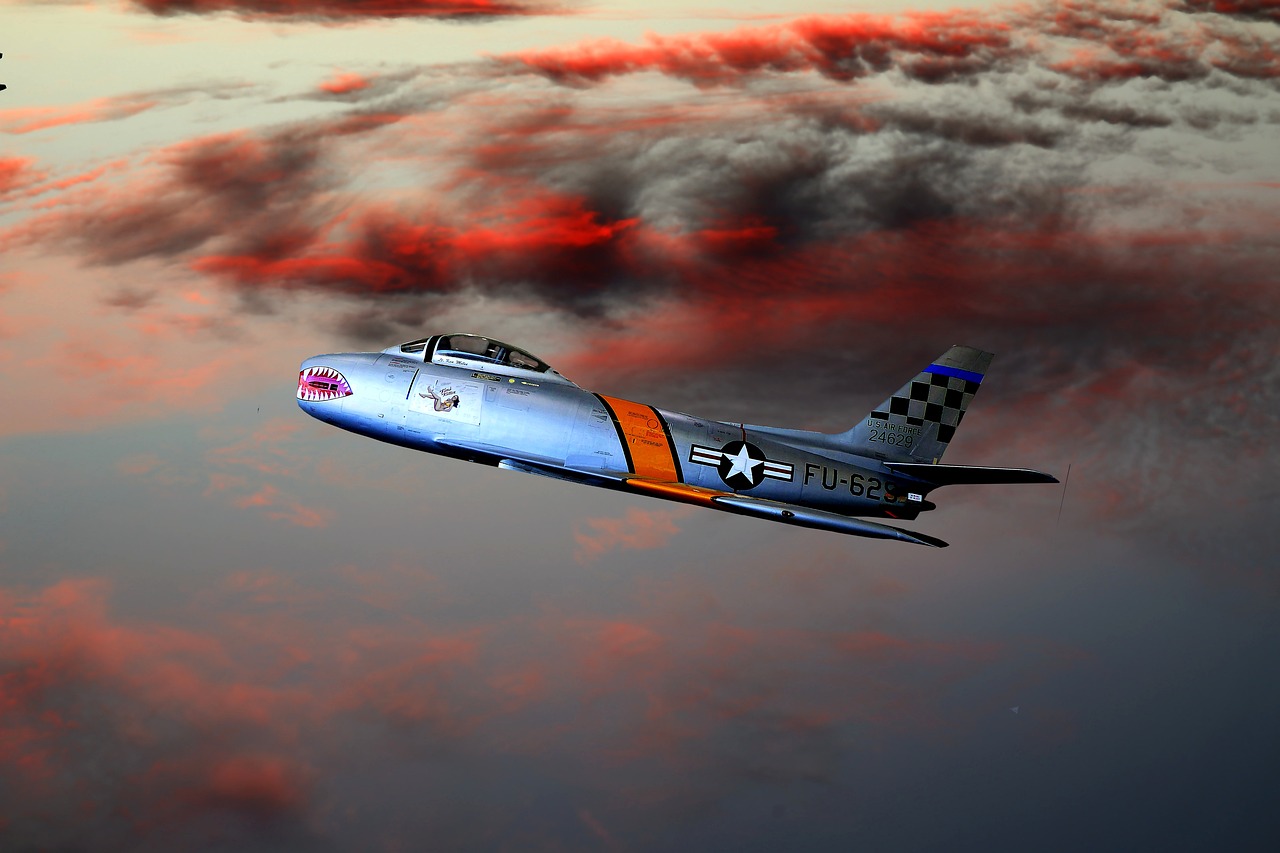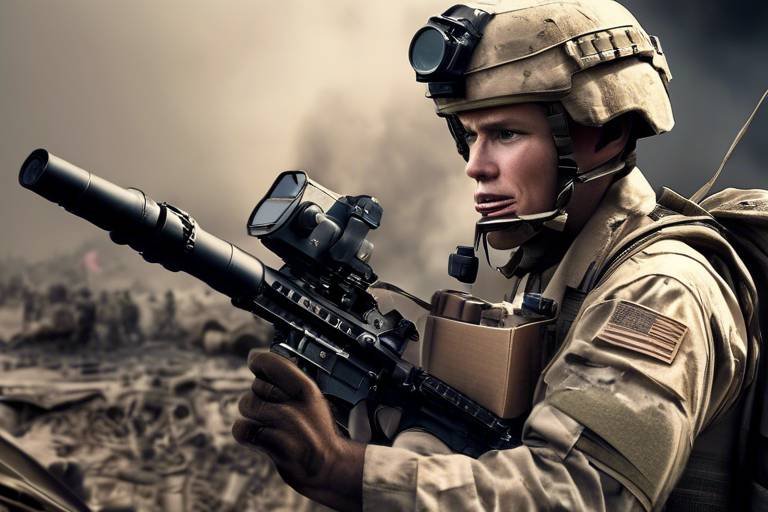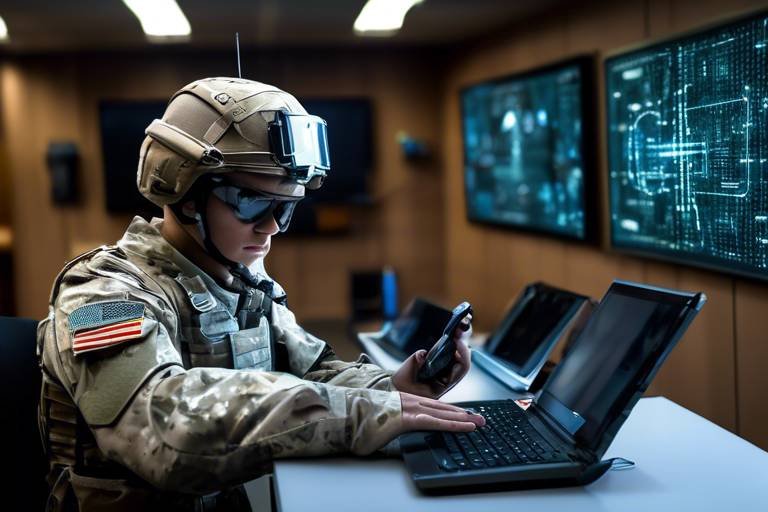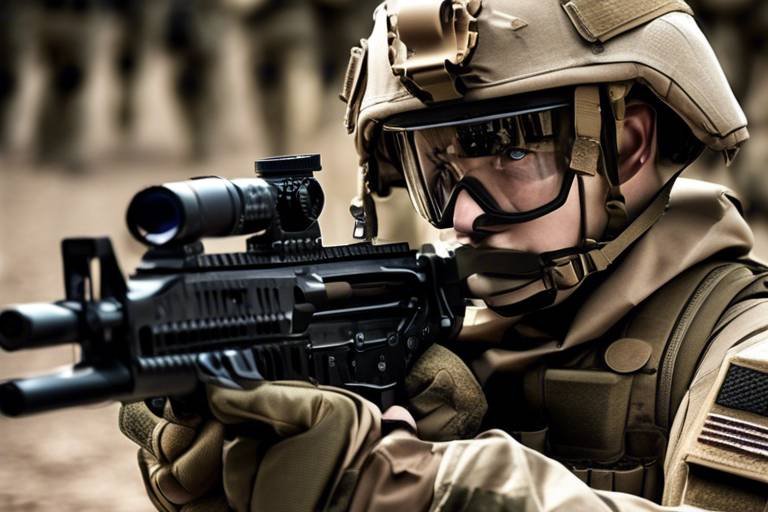AI in Battlefield Sensors - Early Threat Detection
In today's complex and ever-evolving battlefield, the stakes are higher than ever. The integration of artificial intelligence (AI) into battlefield sensors is revolutionizing how military forces operate, enabling them to detect threats earlier and respond more effectively. Imagine a scenario where a soldier can instantly receive alerts about potential dangers, allowing them to make informed decisions in the heat of battle. This is not science fiction; it's the reality being shaped by AI technologies. By enhancing the capabilities of traditional sensors, AI is not only improving military strategies but also saving lives through timely and accurate information.
Battlefield sensors are the eyes and ears of military operations. These critical tools gather data in real-time, providing essential information that allows military forces to monitor their environments, detect threats, and make informed decisions during combat situations. With the vast amount of data generated on the battlefield, the challenge lies in sifting through this information to identify relevant threats. This is where AI steps in, acting as a powerful ally to human operators.
AI enhances threat detection by analyzing vast amounts of data quickly and efficiently. It identifies patterns and predicts potential dangers, significantly improving response times and operational efficiency. For instance, AI can process data from various sources—such as drones, satellites, and ground sensors—simultaneously, enabling a comprehensive understanding of the battlefield landscape. This capability allows military personnel to stay several steps ahead of adversaries, turning the tide in critical situations.
At the heart of AI-driven sensors are machine learning algorithms. These algorithms allow systems to learn from past data, improving their detection capabilities over time and adapting to new threats. As they process more information, these algorithms become increasingly adept at distinguishing between benign activities and genuine threats. This self-improvement is akin to a seasoned soldier honing their skills through experience, making AI an invaluable asset in modern warfare.
Moreover, advanced data processing techniques enable AI systems to filter out noise and focus on relevant signals. This capability is crucial in complex battlefield environments where multiple stimuli can overwhelm human operators. By enhancing the accuracy and reliability of threat detection, AI ensures that military personnel can trust the information they receive, allowing for more confident decision-making.
Real-time analysis powered by AI is another game-changer. Military personnel can receive immediate insights, facilitating quicker decision-making and reducing the risk of surprise attacks. Think of it as having a tactical advisor that never sleeps—always on alert, always ready to provide critical information. This ability to act swiftly can mean the difference between victory and defeat in high-stakes scenarios.
Integrating AI technologies with existing battlefield sensor systems is essential for maximizing effectiveness. This seamless transition not only enhances overall situational awareness but also ensures that current operations are not disrupted. By leveraging existing technologies, military forces can enhance their capabilities without needing to overhaul their entire systems. This integration is akin to upgrading a classic car with modern technology—preserving its essence while boosting performance.
However, despite the numerous advantages of AI in battlefield sensors, challenges remain. Implementing AI technologies comes with hurdles, including concerns over data security, system reliability, and the need for continuous updates to counter evolving threats. As military operations become increasingly reliant on advanced technologies, ensuring the integrity and security of these systems is paramount.
One major concern is cybersecurity. The integration of AI into military systems raises significant risks, necessitating robust measures to protect sensitive data from potential cyber threats and attacks. Just as a fortress needs strong walls to defend against invaders, military systems must be fortified against cyber intrusions.
Additionally, the use of AI in military applications brings forth numerous ethical considerations. The implications of autonomous decision-making in combat scenarios prompt crucial discussions about accountability and the potential for unintended consequences. As we push the boundaries of technology, it is essential to navigate these ethical dilemmas thoughtfully, ensuring that the deployment of AI in warfare aligns with our moral values.
- What are battlefield sensors?
Battlefield sensors are devices that collect data in real-time to help military forces monitor their environment, detect threats, and make informed decisions during combat.
- How does AI improve threat detection?
AI enhances threat detection by quickly analyzing large amounts of data, identifying patterns, and predicting potential dangers, thereby improving response times and operational efficiency.
- What are machine learning algorithms?
Machine learning algorithms are computer programs that allow systems to learn from past data and improve their detection capabilities over time, adapting to new threats as they arise.
- What challenges does AI face in military applications?
Challenges include data security, system reliability, the need for continuous updates, and ethical considerations regarding autonomous decision-making.

Understanding Battlefield Sensors
This article explores the transformative role of artificial intelligence in enhancing battlefield sensors for early threat detection, improving military strategies, and saving lives through timely and accurate information.
Battlefield sensors are critical tools that gather real-time data, enabling military forces to monitor environments, detect threats, and make informed decisions during combat situations. These sensors can range from simple motion detectors to complex surveillance systems equipped with advanced imaging technology. Imagine a soldier on the ground, equipped with a sensor that can instantly relay information about enemy movements or incoming projectiles. This capability can mean the difference between life and death in a high-stakes environment.
At their core, battlefield sensors serve several essential functions:
- Surveillance: Monitoring vast areas for enemy activity.
- Target Acquisition: Identifying and tracking potential threats.
- Environmental Monitoring: Assessing conditions that could impact operations, such as weather changes or hazardous materials.
These sensors come in various forms, including:
| Type of Sensor | Functionality | Example |
|---|---|---|
| Radar Sensors | Detect and track moving objects | Ground-based radar systems |
| Infrared Sensors | Detect heat signatures | Thermal imaging cameras |
| Acoustic Sensors | Detect sounds from distant sources | Microphone arrays for gunfire detection |
The integration of these sensors into military operations has revolutionized how forces engage with potential threats. For instance, a network of sensors can create a comprehensive picture of the battlefield, allowing commanders to make strategic decisions based on real-time data. This interconnectedness not only enhances situational awareness but also fosters a proactive approach to threat management.
Moreover, with the advent of artificial intelligence, the capabilities of these sensors are being pushed even further. AI algorithms can analyze the data collected by these sensors, identifying patterns and anomalies that human operators might miss. This means that potential threats can be detected much earlier, allowing for quicker responses and more effective strategies.
In conclusion, battlefield sensors are indispensable in modern warfare, providing vital information that can significantly impact military operations. As technology continues to evolve, the integration of AI into these systems promises to enhance their effectiveness even further, ensuring that military forces are better prepared for the challenges they face on the battlefield.
Artificial intelligence enhances threat detection by analyzing vast amounts of data quickly, identifying patterns, and predicting potential dangers, thus improving response times and operational efficiency.
Machine learning algorithms are at the heart of AI-driven sensors, allowing systems to learn from past data and improve their detection capabilities over time, adapting to new threats.
Advanced data processing techniques enable AI systems to filter noise and focus on relevant signals, enhancing the accuracy and reliability of threat detection in complex battlefield environments.
Real-time analysis powered by AI allows military personnel to receive immediate insights, facilitating quicker decision-making and reducing the risk of surprise attacks.
Integrating AI technologies with existing battlefield sensor systems ensures a seamless transition, maximizing the effectiveness of current operations while enhancing overall situational awareness.
Despite its advantages, implementing AI in battlefield sensors comes with challenges, including data security, system reliability, and the need for continuous updates to counter evolving threats.
The integration of AI into military systems raises significant cybersecurity concerns, necessitating robust measures to protect sensitive data from potential cyber threats and attacks.
The use of AI in military applications also brings ethical dilemmas, prompting discussions on the implications of autonomous decision-making and the potential for unintended consequences in combat scenarios.
- What are battlefield sensors? Battlefield sensors are devices that collect data in real-time to monitor environments and detect threats during combat.
- How does AI improve threat detection? AI analyzes large datasets quickly, identifies patterns, and predicts potential threats, enhancing response times and operational efficiency.
- What types of sensors are commonly used? Common types include radar sensors, infrared sensors, and acoustic sensors, each serving different functions in threat detection.
- What are the challenges of implementing AI in military systems? Challenges include data security, system reliability, and the need for continuous updates to adapt to new threats.

The Role of AI in Threat Detection
Artificial intelligence is revolutionizing the way military forces approach threat detection. Imagine having a supercharged assistant that can sift through mountains of data in the blink of an eye, spotting patterns and predicting potential dangers before they even arise. This is precisely what AI brings to the table in the realm of battlefield sensors. By leveraging advanced algorithms, AI systems can analyze data from various sources—such as satellite imagery, drone feeds, and ground sensors—to create a comprehensive picture of the battlefield. This capability not only enhances situational awareness but also allows military personnel to make informed decisions quickly, which can be the difference between life and death in combat scenarios.
One of the most significant advantages of AI in threat detection is its ability to identify anomalies. For instance, if a military sensor detects an unusual movement pattern that deviates from the norm, AI can flag this as a potential threat. This is akin to having a vigilant guard dog that senses something off in the environment. By continuously learning from new data, AI systems refine their detection capabilities over time, adapting to emerging threats and becoming more effective with each encounter.
Furthermore, the integration of machine learning algorithms allows AI to improve its performance autonomously. These algorithms analyze historical data, learning what constitutes a threat and what does not. This evolution is similar to how we learn from our experiences—through trial and error. As AI systems encounter new scenarios, they adjust their parameters, ensuring that they remain relevant in an ever-changing battlefield landscape.
Real-time analysis is another critical aspect of AI's role in threat detection. Imagine a scenario where military personnel are receiving live updates about enemy movements or potential ambushes. AI processes incoming data instantaneously, providing actionable insights that can be relayed to commanders on the ground. This rapid response capability is essential in modern warfare, where timing is crucial. The faster a threat is identified, the quicker a countermeasure can be executed, significantly reducing the risk of surprise attacks.
However, it's important to note that while AI enhances threat detection, it does not operate in isolation. The effectiveness of AI-driven systems is maximized when integrated with existing military technologies. This integration ensures that the transition to AI-enhanced operations is smooth and that military personnel can leverage their current systems while benefiting from the advanced capabilities that AI offers. By combining traditional methods with cutting-edge technology, military forces can achieve a level of situational awareness that was previously unimaginable.
- How does AI improve threat detection? AI analyzes vast amounts of data quickly, identifies patterns, and predicts potential threats, which enhances response times and operational efficiency.
- What are machine learning algorithms? These are algorithms that allow AI systems to learn from past data and improve their detection capabilities over time.
- Why is real-time analysis important? It provides immediate insights, facilitating quicker decision-making and reducing the risk of surprise attacks.
- What challenges does AI face in battlefield applications? Challenges include data security, system reliability, and the need for continuous updates to counter evolving threats.

Machine Learning Algorithms
When it comes to enhancing battlefield sensors, are the unsung heroes. These algorithms are designed to mimic human learning processes, allowing systems to analyze historical data and improve their detection capabilities over time. Imagine teaching a child to recognize different types of animals by showing them pictures; similarly, machine learning algorithms learn from past incidents to identify potential threats in real-time.
One of the key advantages of machine learning is its ability to adapt. As new data comes in, the algorithms refine their models, making them increasingly accurate. This is crucial in a battlefield environment where conditions can change rapidly. For instance, if a particular type of drone is detected frequently in one area, the algorithm can adjust its parameters to be more sensitive to that type of threat in the future. This adaptability is akin to a seasoned soldier who learns from each mission, becoming more skilled and aware with every experience.
There are several types of machine learning algorithms that play a vital role in threat detection:
- Supervised Learning: This involves training the algorithm on a labeled dataset, where the correct outputs are known. It’s like teaching a student with a textbook – they learn from examples.
- Unsupervised Learning: Here, the algorithm explores data without pre-existing labels, identifying patterns and groupings on its own. Think of it as a detective piecing together clues without a clear guide.
- Reinforcement Learning: This type rewards the algorithm for making correct decisions, encouraging it to improve its strategies over time. It’s similar to training a dog with treats for good behavior.
These algorithms work in tandem with advanced data processing techniques to filter out noise and focus on relevant signals, which is essential in the chaotic environment of the battlefield. For instance, in a scenario with multiple moving objects, machine learning can help distinguish between friend and foe, ensuring that military personnel receive accurate and actionable intelligence.
Moreover, the integration of machine learning algorithms into existing systems can lead to significant improvements in operational efficiency. They can process vast amounts of data from various sources, such as satellite imagery, ground sensors, and even social media feeds, to provide a comprehensive picture of the battlefield. This real-time analysis not only enhances situational awareness but also allows for quicker decision-making, ultimately saving lives.
In conclusion, machine learning algorithms are a game-changer in the realm of battlefield sensors. By continuously learning and adapting, they provide military forces with the tools they need to stay one step ahead of potential threats. As technology continues to evolve, the role of these algorithms will only become more critical in ensuring the safety and effectiveness of military operations.
- What are machine learning algorithms?
Machine learning algorithms are computational methods that enable systems to learn from data, identify patterns, and improve their performance over time without being explicitly programmed. - How do machine learning algorithms enhance battlefield sensors?
They enhance battlefield sensors by analyzing large datasets to detect threats, adapt to new situations, and provide real-time insights for military personnel. - What types of machine learning algorithms are used in military applications?
Common types include supervised learning, unsupervised learning, and reinforcement learning, each serving different purposes in data analysis and threat detection. - Are there any challenges in implementing machine learning in military systems?
Yes, challenges include ensuring data security, maintaining system reliability, and addressing ethical considerations related to autonomous decision-making.

Data Processing Techniques
This article explores the transformative role of artificial intelligence in enhancing battlefield sensors for early threat detection, improving military strategies, and saving lives through timely and accurate information.
Battlefield sensors are critical tools that gather data in real-time, enabling military forces to monitor environments, detect threats, and make informed decisions during combat situations.
Artificial intelligence enhances threat detection by analyzing vast amounts of data quickly, identifying patterns, and predicting potential dangers, thus improving response times and operational efficiency.
Machine learning algorithms are at the heart of AI-driven sensors, allowing systems to learn from past data and improve their detection capabilities over time, adapting to new threats.
Advanced data processing techniques are pivotal in the realm of AI-driven battlefield sensors. These techniques are designed to sift through the enormous amounts of data generated in combat scenarios, ensuring that military personnel receive only the most relevant information. Imagine trying to find a needle in a haystack; without proper processing, critical insights can easily be overlooked.
One of the most effective methods employed is signal processing, which helps to isolate important signals from background noise. This is particularly crucial in complex environments where multiple data sources are at play. For instance, sensors might pick up the sounds of machinery, chatter, and environmental noises, but through advanced algorithms, they can filter out the irrelevant sounds, honing in on the critical audio cues that indicate a potential threat.
Moreover, data fusion techniques play an essential role in enhancing situational awareness. By combining information from various sensors—such as visual, thermal, and radar—AI systems can create a comprehensive picture of the battlefield. This multi-sensor approach ensures that decision-makers are not operating in silos; instead, they receive a holistic view that can significantly improve their strategic responses.
In addition, predictive analytics is another powerful tool in the data processing arsenal. By utilizing historical data and current trends, AI can forecast potential threats before they manifest. Think of it as having a weather forecast for battle; just as meteorologists predict storms, AI can anticipate enemy movements or actions, allowing military forces to prepare and respond proactively.
To summarize, the integration of these data processing techniques not only enhances the accuracy and reliability of threat detection but also empowers military personnel to act decisively in high-pressure situations. The ability to process and analyze data in real-time is akin to having a sixth sense on the battlefield, transforming how military operations are conducted.
Integrating AI technologies with existing battlefield sensor systems ensures a seamless transition, maximizing the effectiveness of current operations while enhancing overall situational awareness.
Despite its advantages, implementing AI in battlefield sensors comes with challenges, including data security, system reliability, and the need for continuous updates to counter evolving threats.
The integration of AI into military systems raises significant cybersecurity concerns, necessitating robust measures to protect sensitive data from potential cyber threats and attacks.
The use of AI in military applications also brings ethical dilemmas, prompting discussions on the implications of autonomous decision-making and the potential for unintended consequences in combat scenarios.
- What are battlefield sensors? Battlefield sensors are devices used to gather real-time data about the environment, helping military forces detect threats and make informed decisions.
- How does AI improve threat detection? AI analyzes large datasets quickly, identifies patterns, and predicts potential dangers, leading to faster response times and improved operational efficiency.
- What are data fusion techniques? Data fusion techniques combine information from multiple sensors to create a comprehensive view of the battlefield, enhancing situational awareness.
- What challenges exist with AI implementation in military settings? Challenges include cybersecurity concerns, system reliability, and the need for regular updates to address evolving threats.

Real-Time Analysis
This article explores the transformative role of artificial intelligence in enhancing battlefield sensors for early threat detection, improving military strategies, and saving lives through timely and accurate information.
Battlefield sensors are critical tools that gather data in real-time, enabling military forces to monitor environments, detect threats, and make informed decisions during combat situations.
Artificial intelligence enhances threat detection by analyzing vast amounts of data quickly, identifying patterns, and predicting potential dangers, thus improving response times and operational efficiency.
Machine learning algorithms are at the heart of AI-driven sensors, allowing systems to learn from past data and improve their detection capabilities over time, adapting to new threats.
Advanced data processing techniques enable AI systems to filter noise and focus on relevant signals, enhancing the accuracy and reliability of threat detection in complex battlefield environments.
Imagine being in the heat of battle where every second counts. powered by AI is like having a supercharged brain that processes information faster than you can blink. These AI systems continuously analyze incoming data from various sensors, such as drones, ground sensors, and satellite feeds, to provide military personnel with immediate insights. This capability is crucial because it allows for quicker decision-making, which can be the difference between life and death.
For instance, if a soldier receives a notification that a potential threat is approaching, the AI can assess the situation in real-time, considering factors like speed, direction, and previous patterns of enemy movements. This level of analysis not only enhances situational awareness but also reduces the risk of surprise attacks. Think of it as a chess game where the AI is constantly calculating the opponent's next move, providing the players with an upper hand.
The efficiency of real-time analysis can be illustrated in the following table:
| Feature | Benefit |
|---|---|
| Immediate Threat Detection | Allows for instant reaction to potential dangers |
| Data Fusion | Combines information from multiple sources for comprehensive insights |
| Enhanced Decision-Making | Facilitates faster and more informed tactical decisions |
| Reduced Human Error | Minimizes mistakes caused by fatigue or stress |
Moreover, the integration of real-time analysis into battlefield operations means that military forces can adapt their strategies on the fly. If a new threat emerges, the AI can quickly re-evaluate the situation and suggest alternative tactics, ensuring that troops are always one step ahead. This dynamic adaptability is akin to a skilled conductor leading an orchestra, where each instrument (or data source) plays in harmony to create a cohesive response to the chaos of battle.
Integrating AI technologies with existing battlefield sensor systems ensures a seamless transition, maximizing the effectiveness of current operations while enhancing overall situational awareness.
Despite its advantages, implementing AI in battlefield sensors comes with challenges, including data security, system reliability, and the need for continuous updates to counter evolving threats.
The integration of AI into military systems raises significant cybersecurity concerns, necessitating robust measures to protect sensitive data from potential cyber threats and attacks.
The use of AI in military applications also brings ethical dilemmas, prompting discussions on the implications of autonomous decision-making and the potential for unintended consequences in combat scenarios.
- What are battlefield sensors? Battlefield sensors are devices that collect real-time data to help military forces monitor environments and detect threats.
- How does AI improve threat detection? AI analyzes large volumes of data quickly, identifies patterns, and predicts potential threats, enhancing operational efficiency.
- What are the challenges of implementing AI in military systems? Challenges include cybersecurity risks, system reliability, and the need for continuous updates to address evolving threats.
- What ethical concerns are associated with AI in warfare? Ethical concerns revolve around autonomous decision-making and the potential for unintended consequences during combat.

Integration with Existing Systems
Integrating artificial intelligence (AI) technologies with existing battlefield sensor systems is not just a matter of adding new tools; it's about creating a symphony of technology that enhances the capabilities of military operations. Imagine a scenario where traditional sensors, which have long been the backbone of military intelligence, are suddenly empowered with the ability to learn and adapt. This is the promise of AI integration. By combining AI with existing systems, military forces can achieve a level of situational awareness that was previously unimaginable.
One of the key aspects of this integration is ensuring that new AI capabilities can communicate effectively with legacy systems. This involves developing interoperable architectures that allow for seamless data exchange. For instance, AI-enhanced sensors can analyze incoming data from traditional sources, filtering out irrelevant information while highlighting critical threats. This not only maximizes the utility of existing systems but also minimizes the need for extensive retraining of personnel, who are already familiar with the traditional setup.
Moreover, the integration process must address various technical challenges. For example, the AI algorithms need to be compatible with the hardware and software of existing systems. This requires a thorough understanding of both the old and new technologies. Military organizations often face the daunting task of upgrading their systems without disrupting ongoing operations. This is where strategic planning comes into play. By phasing the integration process, military forces can gradually adopt AI technologies while still relying on their tried-and-true systems.
Additionally, the benefits of integrating AI into existing systems can be substantial. Not only does this enhance operational efficiency, but it also leads to improved decision-making processes on the battlefield. For instance, AI can provide real-time analytics that help commanders understand the battlefield landscape better, allowing for more informed tactical decisions. This integration can also facilitate collaborative efforts among various military branches, as AI systems can share insights across different platforms, leading to a unified approach to threat detection and response.
In summary, the integration of AI with existing battlefield sensor systems is a vital step toward modernizing military operations. It enhances the overall effectiveness of current technologies while paving the way for future innovations. As military forces continue to evolve, embracing AI integration will be crucial in maintaining a competitive edge and ensuring the safety of personnel on the ground.
- What are battlefield sensors?
Battlefield sensors are devices that gather data in real-time to help military forces monitor their environment, detect threats, and make informed decisions during combat. - How does AI improve threat detection?
AI enhances threat detection by quickly analyzing large volumes of data, identifying patterns, and predicting potential dangers, which improves response times. - What challenges exist in implementing AI in military systems?
Key challenges include data security, system reliability, and the need for continuous updates to counter evolving threats. - What ethical considerations arise from using AI in military applications?
The use of AI raises ethical dilemmas regarding autonomous decision-making and the potential for unintended consequences in combat scenarios.

Challenges in Implementing AI
While the integration of artificial intelligence (AI) into battlefield sensors promises revolutionary advancements in military operations, it is not without its challenges. One of the most pressing issues is data security. As military systems become increasingly reliant on AI, the amount of sensitive information being processed and stored grows exponentially. This makes them prime targets for cyberattacks. Hackers could potentially manipulate AI algorithms, leading to disastrous outcomes in combat scenarios. Therefore, robust cybersecurity measures are essential to protect against breaches that could compromise mission integrity.
Another significant challenge lies in system reliability. AI systems must be incredibly reliable, especially in high-stakes environments like the battlefield. If an AI-driven sensor fails to detect a threat or provides false information, it can have catastrophic consequences. Ensuring that these systems can operate flawlessly under various conditions requires extensive testing and validation. Moreover, the technology must be able to adapt to the unpredictable nature of warfare, which can be a daunting task.
Additionally, there is the ongoing need for continuous updates to counter evolving threats. Just as military tactics and technologies evolve, so too do the methods used by adversaries. AI systems must be regularly updated with new data and algorithms to ensure they remain effective. This not only requires a significant investment of time and resources but also poses logistical challenges for military organizations that must keep pace with rapid technological advancements.
Furthermore, the integration of AI into military applications raises ethical considerations. As machines take on more decision-making roles, questions arise regarding accountability and the potential for unintended consequences. For instance, if an AI system misidentifies a target, who is responsible for the fallout? This ethical dilemma necessitates a careful examination of how AI is implemented in military operations, ensuring that human oversight remains a critical component of decision-making processes.
In summary, while the potential benefits of AI in battlefield sensors are immense, the challenges associated with data security, system reliability, continuous updates, and ethical considerations cannot be overlooked. Addressing these issues is crucial for the successful implementation of AI technologies in military contexts.
- What are the main challenges of implementing AI in military applications?
The main challenges include data security, system reliability, the need for continuous updates, and ethical considerations surrounding autonomous decision-making.
- How does AI improve threat detection in battlefield sensors?
AI enhances threat detection by analyzing vast amounts of data quickly, identifying patterns, and predicting potential dangers, which improves response times and operational efficiency.
- What are the cybersecurity concerns related to AI in military systems?
Cybersecurity concerns involve protecting sensitive data from potential breaches and ensuring that AI algorithms are not manipulated by adversaries.
- Why is system reliability important for AI in battlefield sensors?
System reliability is crucial because any failure in threat detection could lead to catastrophic consequences in combat scenarios.

Cybersecurity Concerns
The integration of artificial intelligence into battlefield sensors is revolutionizing military operations, but it also raises significant that cannot be overlooked. As these advanced systems become more interconnected and reliant on data, the potential for cyber threats increases dramatically. Imagine a scenario where an enemy could manipulate the very sensors designed to protect our troops; the consequences could be catastrophic. This is why understanding and addressing cybersecurity in AI-driven systems is paramount.
Firstly, the sensitive nature of military data makes it a prime target for cyberattacks. Adversaries are constantly evolving their tactics, seeking vulnerabilities in military networks to exploit. To combat this, military organizations need to implement robust cybersecurity measures that safeguard not only the data but also the integrity of the AI systems themselves. This includes encryption, firewalls, and intrusion detection systems that work in tandem to create a multi-layered defense.
Moreover, the reliance on machine learning algorithms introduces another layer of complexity. These algorithms require vast amounts of data to function effectively, which often means transferring information across networks. Each transfer point is a potential vulnerability. If an adversary can intercept this data, they could potentially feed false information into the system, leading to incorrect threat assessments. Therefore, maintaining data integrity during transmission is crucial.
Additionally, the concept of zero trust architecture is gaining traction in military cybersecurity strategies. This approach assumes that threats could be both external and internal, meaning that every access request must be verified. By adopting this model, military forces can minimize the risk of unauthorized access to their AI systems and sensitive data. Implementing such a framework requires a cultural shift within military organizations, emphasizing the importance of cybersecurity at all levels.
To summarize, the surrounding AI in battlefield sensors are multifaceted and demand immediate attention. The stakes are incredibly high, as the safety of military personnel and the effectiveness of operations depend on the integrity of these systems. As we continue to innovate and integrate AI into military strategies, a proactive approach to cybersecurity will be essential. A collaborative effort between military leaders, cybersecurity experts, and AI developers can help create a resilient defense against evolving cyber threats.
- What are the main cybersecurity threats to AI in battlefield sensors?
The main threats include data breaches, manipulation of sensor data, and unauthorized access to military networks.
- How can military organizations protect their AI systems?
By implementing robust cybersecurity measures such as encryption, zero trust architecture, and continuous monitoring of networks.
- Why is data integrity important in AI systems?
Data integrity ensures that the information used by AI systems is accurate and reliable, which is crucial for effective threat detection and decision-making.
- What role does machine learning play in cybersecurity?
Machine learning can help identify patterns in data that indicate potential security threats, enabling faster response times.

Ethical Considerations
The integration of artificial intelligence into military applications, especially in battlefield sensors, raises a plethora of ethical concerns that cannot be overlooked. As we delve into this complex topic, it’s crucial to consider the implications of allowing machines to make critical decisions that can impact human lives. Are we ready to hand over the reins of life-and-death situations to algorithms? This question is not just hypothetical; it’s a reality we're facing as technology advances at breakneck speed.
One of the primary ethical dilemmas revolves around autonomous decision-making. When AI systems are tasked with identifying threats and potentially engaging them, the question arises: who is responsible for these decisions? If an AI system misidentifies a target and causes collateral damage, can we hold the developers, military leaders, or the machine itself accountable? This ambiguity creates a murky landscape of responsibility that is both unsettling and fraught with complications.
Moreover, there’s the issue of unintended consequences. AI systems, particularly those powered by machine learning, learn from vast datasets. If these datasets are biased or flawed, the AI can develop skewed perceptions of what constitutes a threat. For instance, if an AI system is trained on historical combat data that reflects a particular bias, it may disproportionately target specific groups or areas, leading to ethical violations and potential war crimes. The ramifications of such actions could be devastating, not only for the immediate victims but also for international relations and military credibility.
Another aspect to consider is the dehumanization of warfare. The more we rely on AI to make decisions in combat, the further we drift from the human element that has traditionally guided military actions. Combat is not just a strategic endeavor; it involves moral judgments and empathy, qualities that machines lack. As we integrate AI into battlefield sensors, we risk creating a scenario where soldiers become mere operators of machines rather than decision-makers with moral agency.
To address these ethical concerns, it’s essential to establish a framework that governs the use of AI in military contexts. This framework should include:
- Accountability Measures: Clear guidelines on who is responsible for AI decisions.
- Bias Mitigation: Strategies to ensure AI systems are trained on diverse and representative datasets.
- Human Oversight: Maintaining a human in the loop for critical decision-making processes.
- Ethical Training: Providing military personnel with training on the ethical implications of using AI in combat.
In conclusion, while the potential benefits of AI in battlefield sensors are significant, we must tread carefully. The ethical considerations surrounding autonomous decision-making, unintended consequences, and the dehumanization of warfare are profound and necessitate thorough examination and proactive measures. As we push the boundaries of technology, we must also reinforce our commitment to ethical standards that respect human life and dignity.
1. What are the main ethical concerns regarding AI in military applications?
The primary concerns include autonomous decision-making accountability, unintended consequences from biased data, and the dehumanization of warfare.
2. How can we ensure AI systems are unbiased?
By training AI on diverse and representative datasets and implementing rigorous testing to identify and mitigate biases.
3. Is human oversight necessary in AI decision-making?
Yes, maintaining a human in the loop is crucial to ensure moral and ethical considerations are taken into account during critical decisions.
4. What steps can military organizations take to address ethical issues?
Establishing clear accountability measures, providing ethical training, and creating guidelines for AI use in combat scenarios are essential steps.
Frequently Asked Questions
- What are battlefield sensors?
Battlefield sensors are advanced tools used by military forces to collect real-time data about their environment. They help in monitoring troop movements, detecting threats, and enabling informed decision-making during combat situations. Think of them as the eyes and ears of the military, providing critical information when it matters most.
- How does AI enhance threat detection in battlefield sensors?
AI enhances threat detection by rapidly analyzing massive amounts of data, identifying patterns, and predicting potential dangers. This means that military personnel can respond faster and more efficiently to emerging threats, significantly improving operational effectiveness. It's like having a supercharged assistant that never sleeps!
- What role do machine learning algorithms play in AI-driven sensors?
Machine learning algorithms are essential for AI-driven sensors as they allow these systems to learn from historical data. Over time, they adapt to new threats, improving their detection capabilities. Imagine teaching a child to recognize shapes; the more they practice, the better they become, and that’s exactly how these algorithms work!
- What are the challenges of implementing AI in battlefield sensors?
Implementing AI in battlefield sensors can be challenging due to concerns about data security, system reliability, and the need for continuous updates to keep pace with evolving threats. It's crucial to ensure that these systems are not only effective but also secure from cyber threats that could compromise sensitive information.
- Are there ethical concerns regarding AI in military applications?
Yes, the use of AI in military applications raises several ethical dilemmas. Discussions often revolve around the implications of autonomous decision-making and the potential for unintended consequences during combat scenarios. It’s a delicate balance between leveraging technology for safety and maintaining human oversight in critical decisions.
- How does real-time analysis improve military operations?
Real-time analysis powered by AI provides immediate insights to military personnel, allowing for quicker decision-making. This capability helps in reducing the risk of surprise attacks and enhances overall situational awareness, making it a game-changer on the battlefield.
- Can AI systems integrate with existing battlefield sensor technologies?
Absolutely! Integrating AI technologies with existing battlefield sensor systems is crucial for maximizing effectiveness. This seamless transition helps enhance current operations while providing a boost in situational awareness, ensuring that military forces can adapt to new challenges without starting from scratch.



















